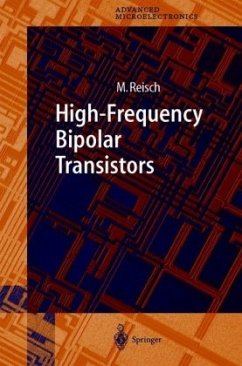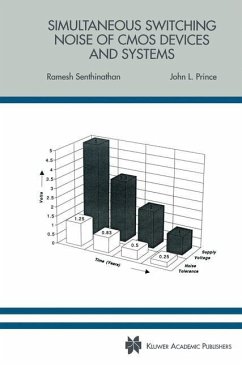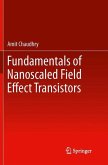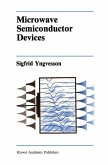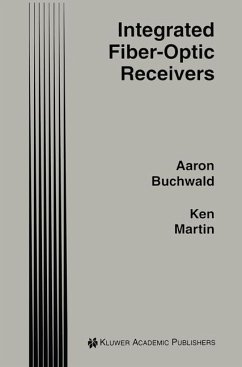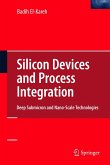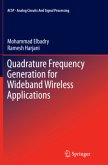Michael Reisch
High-Frequency Bipolar Transistors
Michael Reisch
High-Frequency Bipolar Transistors
- Broschiertes Buch
- Merkliste
- Auf die Merkliste
- Bewerten Bewerten
- Teilen
- Produkt teilen
- Produkterinnerung
- Produkterinnerung
This book provides a rather comprehensive presentation of the physics and modeling of high-frequency bipolar transistors with particular emphasis given to silicon-based devices. I hope it will be found useful by those who do as well as by those who intend to work in the field, as it compiles and extends material presented in numerous publications in a coherent fashion. I've worked on this project for years and did my best to avoid errors. De spite all efforts it is possible that "something" has been overlooked during copy-editing and proof-reading. If you find a mistake please let me know.…mehr
Andere Kunden interessierten sich auch für
![Simultaneous Switching Noise of CMOS Devices and Systems Simultaneous Switching Noise of CMOS Devices and Systems]() Ramesh SenthinathanSimultaneous Switching Noise of CMOS Devices and Systems75,99 €
Ramesh SenthinathanSimultaneous Switching Noise of CMOS Devices and Systems75,99 €![Fundamentals of Nanoscaled Field Effect Transistors Fundamentals of Nanoscaled Field Effect Transistors]() Amit ChaudhryFundamentals of Nanoscaled Field Effect Transistors75,99 €
Amit ChaudhryFundamentals of Nanoscaled Field Effect Transistors75,99 €![Microwave Semiconductor Devices Microwave Semiconductor Devices]() Sigfrid YngvessonMicrowave Semiconductor Devices115,99 €
Sigfrid YngvessonMicrowave Semiconductor Devices115,99 €![Integrated Fiber-Optic Receivers Integrated Fiber-Optic Receivers]() Aaron BuchwaldIntegrated Fiber-Optic Receivers153,99 €
Aaron BuchwaldIntegrated Fiber-Optic Receivers153,99 €![Silicon Devices and Process Integration Silicon Devices and Process Integration]() Badih El-KarehSilicon Devices and Process Integration113,99 €
Badih El-KarehSilicon Devices and Process Integration113,99 €![Quadrature Frequency Generation for Wideband Wireless Applications Quadrature Frequency Generation for Wideband Wireless Applications]() Mohammad ElbadryQuadrature Frequency Generation for Wideband Wireless Applications75,99 €
Mohammad ElbadryQuadrature Frequency Generation for Wideband Wireless Applications75,99 €![CMOS Single Chip Fast Frequency Hopping Synthesizers for Wireless Multi-Gigahertz Applications CMOS Single Chip Fast Frequency Hopping Synthesizers for Wireless Multi-Gigahertz Applications]() Taoufik BourdiCMOS Single Chip Fast Frequency Hopping Synthesizers for Wireless Multi-Gigahertz Applications110,99 €
Taoufik BourdiCMOS Single Chip Fast Frequency Hopping Synthesizers for Wireless Multi-Gigahertz Applications110,99 €-
-
-
This book provides a rather comprehensive presentation of the physics and modeling of high-frequency bipolar transistors with particular emphasis given to silicon-based devices. I hope it will be found useful by those who do as well as by those who intend to work in the field, as it compiles and extends material presented in numerous publications in a coherent fashion. I've worked on this project for years and did my best to avoid errors. De spite all efforts it is possible that "something" has been overlooked during copy-editing and proof-reading. If you find a mistake please let me know. Michael Reisch Kempten, December 2002 Notation It is intended here to use the most widely employed notation, in cases where the standard textbook notation is different from the SPICE notation, the latter is used. In order to make formulas more readable, model parameters represented in SPICE by a series of capital letters are written here as one capital letter with the rest in the form of a subscript (e.g. XCJC is used here instead of the XCJC used in the SPICE input). Concerning the use of lower-case and capital letters, the following rules are applied: - Time-dependent large-signal quantities are represented by lower-case let ters. The variables 't, v and p therefore denote time-dependent current, voltage and power values.
Hinweis: Dieser Artikel kann nur an eine deutsche Lieferadresse ausgeliefert werden.
Hinweis: Dieser Artikel kann nur an eine deutsche Lieferadresse ausgeliefert werden.
Produktdetails
- Produktdetails
- Springer Series in Advanced Microelectronics 11
- Verlag: Springer / Springer Berlin Heidelberg / Springer, Berlin
- Artikelnr. des Verlages: 978-3-642-63205-1
- Softcover reprint of the original 1st ed. 2003
- Seitenzahl: 680
- Erscheinungstermin: 21. Oktober 2012
- Englisch
- Abmessung: 235mm x 155mm x 37mm
- Gewicht: 1013g
- ISBN-13: 9783642632051
- ISBN-10: 364263205X
- Artikelnr.: 39511502
- Herstellerkennzeichnung
- Springer-Verlag GmbH
- Tiergartenstr. 17
- 69121 Heidelberg
- ProductSafety@springernature.com
- Springer Series in Advanced Microelectronics 11
- Verlag: Springer / Springer Berlin Heidelberg / Springer, Berlin
- Artikelnr. des Verlages: 978-3-642-63205-1
- Softcover reprint of the original 1st ed. 2003
- Seitenzahl: 680
- Erscheinungstermin: 21. Oktober 2012
- Englisch
- Abmessung: 235mm x 155mm x 37mm
- Gewicht: 1013g
- ISBN-13: 9783642632051
- ISBN-10: 364263205X
- Artikelnr.: 39511502
- Herstellerkennzeichnung
- Springer-Verlag GmbH
- Tiergartenstr. 17
- 69121 Heidelberg
- ProductSafety@springernature.com
Michael Reisch wurde 1957 im oberschwäbischen Bad Waldsee geboren. Er studierte Physik an der TU München und promovierte am Institut für Physikalische Elektronik der TU Wien. Er war von 1983 bis 1991 für die Siemens AG (Zentrale Forschung und Entwicklung) in München tätig. Seit 1991 ist er als Professor an der FH Kempten vor allem für die Lehrgebiete Werkstoffe der Elektrotechnik sowie Elektronische Bauelemente zuständig. Sein berufliches Hauptinteresse gilt der Physik und Modellierung elektronischer Bauelemente - in seiner Freizeit ist er am liebsten mit Tourenski oder Mountainbike in den Bergen unterwegs.
1. An Introductory Survey.- 1.1 History.- 1.2 Devices, Circuits, Compact Models.- 1.3 Semiconductors.- 1.4 PN Junctions.- 1.5 Bipolar Transistor Principles.- 1.6 Elementary Large-Signal Models.- 1.7 Elementary Small-Signal Models.- 1.8 Noise Modeling.- 1.9 Orders of Magnitude.- 1.10 References.- 2. Semiconductor Physics Required for Bipolar-Transistor Modeling.- 2.1 Band Structure.- 2.2 Thermal Equilibrium.- 2.3 The Boltzmann Equation.- 2.4 The Drift-Diffusion Approximation.- 2.5 Hydrodynamic Model.- 2.6 Generation and Recombination.- 2.7 Heavily Doped Semiconductors.- 2.8 Silicon Device Modeling in the Drift-Diffusion Approximation.- 2.9 References.- 3. Physics and Modeling of Bipolar Junction Transistors.- 3.1 The Regional Approach.- 3.2 Transfer Current, Early Effect.- 3.3 Emitter-Base Diode, Current Gain.- 3.4 Base-Collector Diode, Breakdown.- 3.5 Charge Storage, Transit Time.- 3.6 Series Resistances.- 3.7 High-Level Injection.- 3.8 The Gummel-Poon Model.- 3.9 Small-Signal Description.- 3.10 Figures of Merit.- 3.11 Temperature Dependences, Self-Heating.- 3.12 Parameter Extraction - DC Measurements.- 3.13 Parameter Extraction - AC Measurements.- 3.14 The VBIC Model.- 3.15 The HICUM Model.- 3.16 The MEXTRAM Model.- 3.17 References.- 4. Physics and Modeling of Heterojunction Bipolar Transistors.- 4.1 Heterojunctions.- 4.2 Heterojunction Bipolar Transistors.- 4.3 Silicon-Based Semiconductor Hctorostructures.- 4.4 SiGe HBTs.- 4.5 Compound Semiconductor HBTs.- 4.6 References.- 5. Noise Modeling.- 5.1 Noise in Semiconductors.- 5.2 Transport Theory of Noise.- 5.3 Noise of pn Junctions.- 5.4 Noise Generated by the Transfer Current.- 5.5 High-Frequency Noise Equivalent Circuit.- 5.6 Noise Figure.- 5.7 Low-Frequency Noise.- 5.8 References.- 6. Basic CircuitConfigurations.- 6.1 Common-Emitter Configuration.- 6.2 Common-Collector Configuration.- 6.3 Common-Base Configuration.- 6.4 The Diode-Connected Bipolar Transistor.- 6.5 Current Sources and Active Loads.- 6.6 Differential Amplifiers.- 6.7 Analog Multipliers.- 6.8 Two-Transistor Amplifier Stages.- 6.9 Bandgap References.- 6.10 Digital Circuits.- 6.11 References.- 7. Process Integration.- 7.1 Fabrication of Integrated npn Transistors.- 7.2 Passive Components.- 7.3 PNP Transistors.- 7.4 Reliability.- 7.5 References.- 8. Applications.- 8.1 Emitter-Coupled Logic.- 8.2 High-Speed Optical Transmission Systems.- 8.3 RF Microelectronics.- 8.4 BiCMOS.- 8.5 References.- A. Linear and Nonlinear Response.- A.1 Linear Response.- A.1.1 Step Response, Elmore Delay.- A.2 Nonlinear Systems Without Memory.- A.2.1 Harmonic Distortion, Gain Compression.- A.2.2 Intermodulation Distortion.- A.3 Nonlinear Systems with Memory.- A.3.1 Volterra Series.- A.4 References.- B. Linear Two-Ports, s-Parameters.- B.1 Indefinite Admittance Matrix.- B.2 Terminated Two-Ports.- B.2.1 Input and Output Impedance.- B.2.2 Voltage and Current Gain.- B.2.3 Power Gain.- B.2.4 Stability.- B.2.5 Incident and Reflected Power.- B.3 S-Parameters.- B.3.1 Relations between s-Parameters and Two-Port Parameters.- B.3.2 Matching and Power Gain.- B.4 References.- C. PN Junctions: Details.- C.1 Boundary Conditions at PN Junctions.- C.2 Epitaxial Diode.- C.3 Minority-Carrier Transport in Heavily Doped Emitter Regions.- C.4 High-Frequency Diode Admittance.- C.5 References.- D. Bipolar Transistor: Details.- D.1 Drift Transistor.- D.1.1 Electron Transport Through the Base Region.- D.1.3 Excess Phase.- D.1.4 Collector Transit Time.- D.1.5 Small-Signal Analysis.- D.2 Quasi-Thrce-Dimensional Computations of the Base Resistance.- D.3Generation of Model Parameters from Layout Data.- D.4 Generalization of the Gummol Transfer Current Relation to Arbitrary Geometries.- D.5 Definition of Series Resistances Within the Integral Charge Control Relation.- D.6 Multiplication Factor.- D.7 References.- E. Noise: Details.- E.1 Some Statistics.- E.1.1 Stochastic Variables, Correlation.- E.1.2 Ensemble Average, Distribution Function.- E.1.3 Spectral Density.- E.1.4 Carson Theorem, Shot Noise.- E.2 Velocity Fluctuations and Diffusion.- E.3 Thermodynamics and Noise.- E.4 Generation-Recombination Noise.- E.5 McWorther Model of 1/f Noise.- E.6 Short-Base Diode with Metal Contact.- E.7 Short-Base Diode with Polysilicon Contact.- E.8 Equivalent-Circuit Representation of Transfer Current Noise.- E.9 References.- F. Overtemperature Developed During Electrostatic Discharges.- F.1 Thermal Conductivity.- F.2 Transient Overtemperature During a Short Pulse.- F.3 References.
1. An Introductory Survey.- 1.1 History.- 1.2 Devices, Circuits, Compact Models.- 1.3 Semiconductors.- 1.4 PN Junctions.- 1.5 Bipolar Transistor Principles.- 1.6 Elementary Large-Signal Models.- 1.7 Elementary Small-Signal Models.- 1.8 Noise Modeling.- 1.9 Orders of Magnitude.- 1.10 References.- 2. Semiconductor Physics Required for Bipolar-Transistor Modeling.- 2.1 Band Structure.- 2.2 Thermal Equilibrium.- 2.3 The Boltzmann Equation.- 2.4 The Drift-Diffusion Approximation.- 2.5 Hydrodynamic Model.- 2.6 Generation and Recombination.- 2.7 Heavily Doped Semiconductors.- 2.8 Silicon Device Modeling in the Drift-Diffusion Approximation.- 2.9 References.- 3. Physics and Modeling of Bipolar Junction Transistors.- 3.1 The Regional Approach.- 3.2 Transfer Current, Early Effect.- 3.3 Emitter-Base Diode, Current Gain.- 3.4 Base-Collector Diode, Breakdown.- 3.5 Charge Storage, Transit Time.- 3.6 Series Resistances.- 3.7 High-Level Injection.- 3.8 The Gummel-Poon Model.- 3.9 Small-Signal Description.- 3.10 Figures of Merit.- 3.11 Temperature Dependences, Self-Heating.- 3.12 Parameter Extraction - DC Measurements.- 3.13 Parameter Extraction - AC Measurements.- 3.14 The VBIC Model.- 3.15 The HICUM Model.- 3.16 The MEXTRAM Model.- 3.17 References.- 4. Physics and Modeling of Heterojunction Bipolar Transistors.- 4.1 Heterojunctions.- 4.2 Heterojunction Bipolar Transistors.- 4.3 Silicon-Based Semiconductor Hctorostructures.- 4.4 SiGe HBTs.- 4.5 Compound Semiconductor HBTs.- 4.6 References.- 5. Noise Modeling.- 5.1 Noise in Semiconductors.- 5.2 Transport Theory of Noise.- 5.3 Noise of pn Junctions.- 5.4 Noise Generated by the Transfer Current.- 5.5 High-Frequency Noise Equivalent Circuit.- 5.6 Noise Figure.- 5.7 Low-Frequency Noise.- 5.8 References.- 6. Basic CircuitConfigurations.- 6.1 Common-Emitter Configuration.- 6.2 Common-Collector Configuration.- 6.3 Common-Base Configuration.- 6.4 The Diode-Connected Bipolar Transistor.- 6.5 Current Sources and Active Loads.- 6.6 Differential Amplifiers.- 6.7 Analog Multipliers.- 6.8 Two-Transistor Amplifier Stages.- 6.9 Bandgap References.- 6.10 Digital Circuits.- 6.11 References.- 7. Process Integration.- 7.1 Fabrication of Integrated npn Transistors.- 7.2 Passive Components.- 7.3 PNP Transistors.- 7.4 Reliability.- 7.5 References.- 8. Applications.- 8.1 Emitter-Coupled Logic.- 8.2 High-Speed Optical Transmission Systems.- 8.3 RF Microelectronics.- 8.4 BiCMOS.- 8.5 References.- A. Linear and Nonlinear Response.- A.1 Linear Response.- A.1.1 Step Response, Elmore Delay.- A.2 Nonlinear Systems Without Memory.- A.2.1 Harmonic Distortion, Gain Compression.- A.2.2 Intermodulation Distortion.- A.3 Nonlinear Systems with Memory.- A.3.1 Volterra Series.- A.4 References.- B. Linear Two-Ports, s-Parameters.- B.1 Indefinite Admittance Matrix.- B.2 Terminated Two-Ports.- B.2.1 Input and Output Impedance.- B.2.2 Voltage and Current Gain.- B.2.3 Power Gain.- B.2.4 Stability.- B.2.5 Incident and Reflected Power.- B.3 S-Parameters.- B.3.1 Relations between s-Parameters and Two-Port Parameters.- B.3.2 Matching and Power Gain.- B.4 References.- C. PN Junctions: Details.- C.1 Boundary Conditions at PN Junctions.- C.2 Epitaxial Diode.- C.3 Minority-Carrier Transport in Heavily Doped Emitter Regions.- C.4 High-Frequency Diode Admittance.- C.5 References.- D. Bipolar Transistor: Details.- D.1 Drift Transistor.- D.1.1 Electron Transport Through the Base Region.- D.1.3 Excess Phase.- D.1.4 Collector Transit Time.- D.1.5 Small-Signal Analysis.- D.2 Quasi-Thrce-Dimensional Computations of the Base Resistance.- D.3Generation of Model Parameters from Layout Data.- D.4 Generalization of the Gummol Transfer Current Relation to Arbitrary Geometries.- D.5 Definition of Series Resistances Within the Integral Charge Control Relation.- D.6 Multiplication Factor.- D.7 References.- E. Noise: Details.- E.1 Some Statistics.- E.1.1 Stochastic Variables, Correlation.- E.1.2 Ensemble Average, Distribution Function.- E.1.3 Spectral Density.- E.1.4 Carson Theorem, Shot Noise.- E.2 Velocity Fluctuations and Diffusion.- E.3 Thermodynamics and Noise.- E.4 Generation-Recombination Noise.- E.5 McWorther Model of 1/f Noise.- E.6 Short-Base Diode with Metal Contact.- E.7 Short-Base Diode with Polysilicon Contact.- E.8 Equivalent-Circuit Representation of Transfer Current Noise.- E.9 References.- F. Overtemperature Developed During Electrostatic Discharges.- F.1 Thermal Conductivity.- F.2 Transient Overtemperature During a Short Pulse.- F.3 References.

